Menu
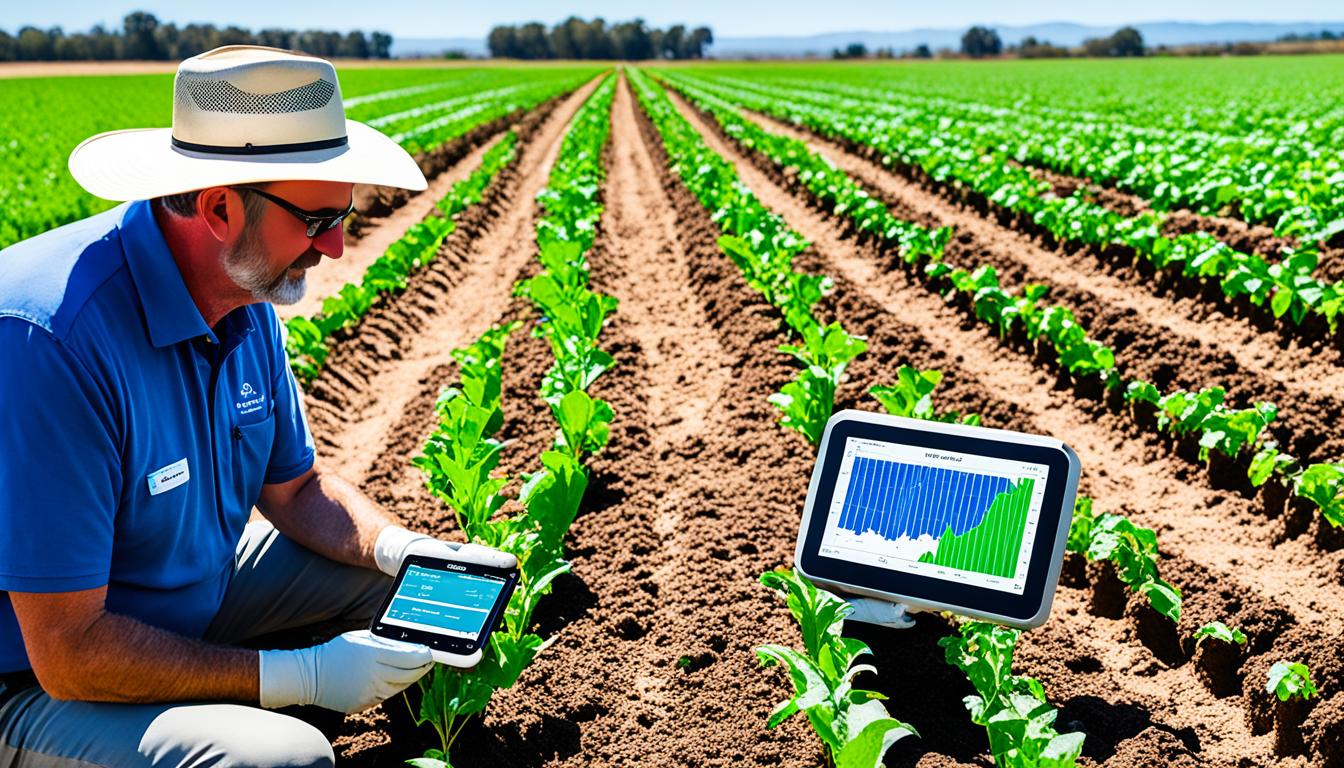
How does technology tackle the challenge of feeding more people while keeping farms safe? With the global population set to grow by 2 billion before 2050, sustainable farming faces huge demands. The United Nations warns we may need 70% more food soon. So, using IoT in farming is key. This approach, boosted by smart farming tech, brings monitoring tools that make farms safer. They protect workers and keep farms productive, despite worldwide challenges.
Internet of Things (IoT) is a network of devices that connect and exchange data. In farming, IoT is changing the game. It helps farmers make real-time decisions based on accurate data. This is very important in today’s complex farming world.
IoT links devices together to share information easily. Devices have sensors, software, and more to collect and share data. It gives farmers more control, increases safety, and uses resources better.
IoT is crucial in today’s farming. Devices give lots of data about the weather, soil, and crops. This data helps farmers make smart choices. The United Nations says we’ll need to produce more food by 2050. So, farming needs to be efficient and productive.
Farmers benefit a lot from IoT. They save money on labour, water, and inputs. They can also stand out by farming sustainably. IoT helps with looking after animals too. It checks their health, where they are, and what they’re doing. This makes farms work better and safer.
IoT also helps make supply chains better. It cuts down on wasted food after harvest. With IoT, farms can water crops more wisely and get weather updates. These updates are very accurate, which helps plan well. Plus, using all the data from IoT devices, farmers can keep getting better at what they do.
| Benefits of IoT in Farming | Percentage/Impact |
|---|---|
| Increase in Crop Yields | 20-30% |
| Reduction in Fertilizer Application | 10-20% |
| Improvement in Early Illness Detection in Livestock | 80% |
| Reduction in Water and Pesticide Usage | 15-20% |
| Reduction in Labor Costs | 25-30% |
| Accuracy in Pest Outbreak Prediction | Over 90% |
Overall, IoT is making farming smarter and more sustainable. It’s helping us meet the challenge of feeding a growing global population.
Using IoT in farm safety boosts security, keeping workers and animals safe. It’s critical as the world’s population grows, hitting 9.7 billion in 2050 and maybe 11 billion by 2100. We need to raise farm output while looking after everyone working on the farm. I explain here how IoT helps make workers safer and guards the animals.
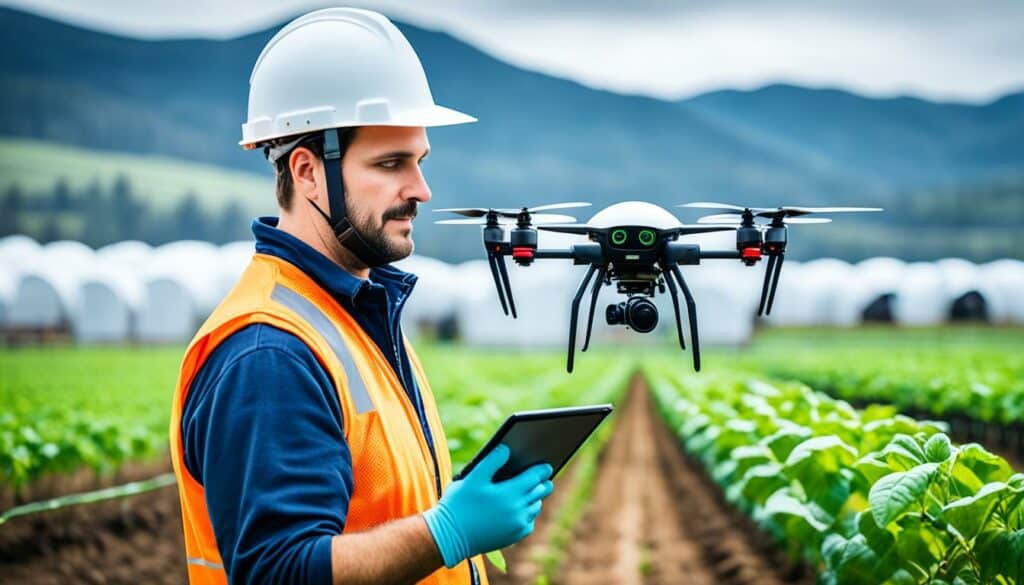
Improving safety for farm workers with IoT is a big step for sustainable farming. Systems that watch over workers, like wearable tech and sensors, can stop accidents. They also cut down the chance of getting hurt. In the UK, the Health and Safety Executive keeps a close eye on deadly accidents in farming, forestry, and fishing. These technologies have come a long way, and now they can keep an eye on workers’ health around the clock using IoT. This means they can jump in with help before things get really bad, keeping workers safe.
Fall detection is a key use of IoT. Research has found that both on-body and off-body sensors can spot falls and warn straight away. This quick action can save lives, especially in remote farm areas. Adding predictive technology and smart algorithms improves these systems. They can guess how people move and can stop accidents before they happen.
IoT helps a lot with looking after farm animals too. Systems that watch over the animals give instant details on their health, where they are, and what they’re doing. This lets farmers deal with any problems early. Using IoT in livestock means they can spot health problems fast, making it easier to care for them.
As an example, IoT gadgets gather loads of details on the weather, soil, and crops. This is really useful for keeping track of the animals’ health and behaviour. By using sensors and wearable tech, all this ties together. It sends alerts to the farmers if the animals show any signs of being sick. This helps the animals stay healthier and stops diseases from spreading.
| Objective | Application | Impact |
|---|---|---|
| Enhancing Worker Safety | Wearable Health Monitoring Systems | Reduced Injuries and Fatalities |
| Protecting Livestock | Real-time Health and Behaviour Tracking | Improved Animal Welfare and Management |
Farmers can make their farm work better with crop tech. IoT sensors give exact info on the soil and crops. This helps farmers make smart choices based on data.
This real-time info makes sure plants get the best care. It helps in getting bigger harvests and wastes less. Zhang et al.’s study found big boosts in how we use resources with IoT.
Precision agriculture in IoT is great for using fertiliser and pesticides well. With smart tech, farmers can apply these things right where it’s needed. Fukatsu and Nanseki’s work proves this. It raises productivity and helps the environment too.
LoRaWAN tech can keep these IoT devices running for up to 15 years. This makes them reliable and good for the planet. It’s a win-win.
Also, smart irrigation with IoT can cut water use by up to 50%. This helps the economy and the environment. It supports growing more food while farming sustainably.
Smart farming is changing the way we do agriculture. It uses artificial intelligence and data analytics to make farming more effective. This change is happening right when we need to feed nearly 10 billion people by 2050.
Agriculture Technology (AgTech) brings new technologies together with old methods. It aims to increase food production while lessening the harm to our planet.
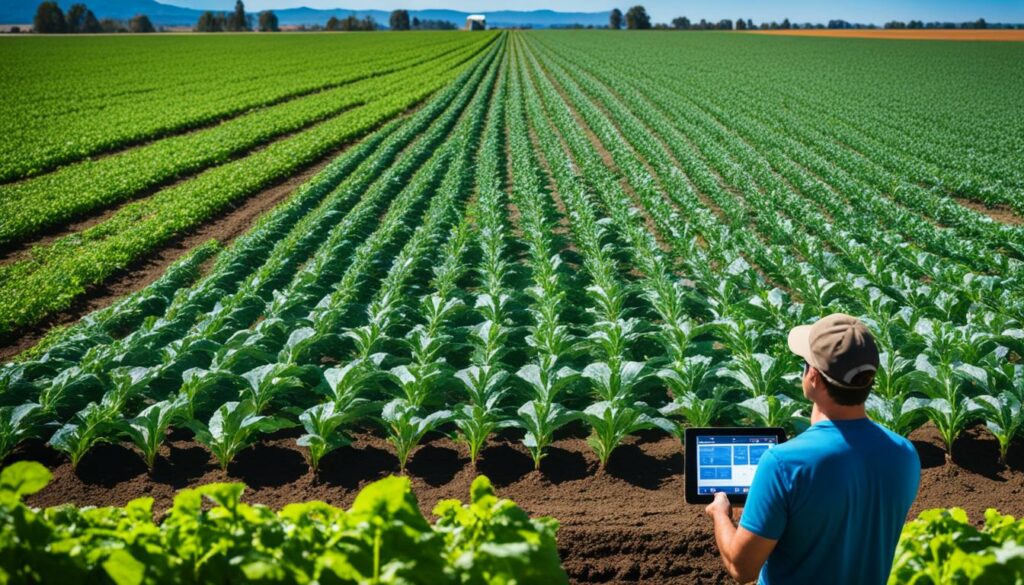
Artificial intelligence is making a big difference in farming. It processes a lot of farming data quickly. This helps farmers make better decisions, leading to healthier crops and better yields.
For example, precision farming uses AI with data from soil moisture and nutrients sensors. This information helps in choosing the best farm activities.
Data analytics are vital for today’s farming. They help farmers plan well and manage their resources better. Also, drones and robots check crops, find issues early, and cut costs by reducing the need for people to do repetitive tasks.
IoT, sensors, and GPS are also part of smart farming. They’re used globally to better farm output. These technologies are making farming smarter and more eco-friendly, especially in poorer countries. This work will keep growing with more advanced AI. It will make farms even more automated and able to change quickly with the weather, soil, and crop needs.
Sensor networks are changing farming by offering real-time monitoring. They give farmers important info on the environment. This helps with making smart choices for farm management. With these networks, farm data is used to manage things right now.
Many sensors are key in today’s farms. Sensors for the soil and climate check moisture, temperature, and humidity. Using them means always having the latest data, which helps with quick actions and saving resources. Research shows using this tech improves both productivity and how sustainable a farm is.
Watch soil and weather closely is important for doing farming perfectly. Sensors for the soil and climate notice changes in moisture and temperature. This gives the best advice for when to water and fertilise. They also track the weather, helping to plan farm activities. Farming smarter with this data means crops stay healthy no matter what the weather does.
Studies by Fukatsu and Nanseki prove how well embedded sensors work on farms. They show that sensor networks are key to understanding the whole farm environment. This knowledge leads to better managing the farm, making things safer and more productive.
Farm automation and robotics are changing the face of agriculture. They help deal with labour shortages and cutting costs. This makes farming more efficient.
By 2050, the world needs to produce 70% more food. This is because there will be around 9.7 billion people. Farming costs a lot, with more than half going towards labour. Many farmers are finding it hard to get enough workers.
Thanks to automation, productivity is surging. For example, a strawberry robot can pick in three days what takes 30 workers weeks to do. Also, by using robots to weed, farmers can use less pesticide.
In 2019, new farm tech startups got a total of $4.7 billion. They are making farming smarter and more efficient. For example, Iron Ox grows plants in water rather than soil. This method uses less water but gets more produce.

Drone technology is changing how farmers keep an eye on their crops. Drones are much quicker than people. They help with various tasks such as checking crops and applying pesticides.
This high-tech farming aims to grow more food and lower costs. It means fresher food for us and less trouble in getting it. Innovations like Root A.I.’s AI help improve how we grow things.
Automation and robotics are key for the future of farming. They will help meet the growing food demand, lessen the need for workers, and make farming greener.
| Statistics | Impact |
|---|---|
| Global population projected to reach 9.7 billion by 2050 | Need for 70% increase in agricultural production |
| Labour costs account for over 50% of farm expenses | Adoption of automated machinery reduces expenditure |
| Single strawberry robot harvester | Replaces 30 farm workers, covers 25 acres in 3 days |
| Weeding robotics | Reduce pesticide usage by up to 90% |
| Use of drones in agriculture | 6 times more effective than human labour |
| Iron Ox hydroponic system | Uses one-tenth the water, yields 30 times greater |
| Farm tech startups raised $4.7 billion in 2019 | Significant funding, 37% increase year-over-year |
The rise of IoT is changing how we watch over animals on farms. It uses smart tech to keep track of their health and actions. This leads to better care and big steps forward in farming.
Farm animals’ health is key for farming to work well and last long. Now, IoT tech uses sensors to monitor things like temperature and air quality. This makes sure animals have the best living conditions possible.
In 2016, sensors made up over half of the tech in this field. A big company, Streamline, is putting lots of effort into improving how we look after animals. They plan to use a huge number of advanced devices in the next few years.
The use of IoT in farming is expected to grow a lot in the coming years. By 2029, it could be worth over 11 billion dollars. IoT is great because it helps farmers get real-time info on their animals’ health and reproduction, which helps them make better decisions.
Thanks to IoT, we now understand animals’ behaviour better. Devices with LoRa tech help find animals if they get lost or stolen. This tech is also good for making sure animals are comfortable and using farm resources wisely.
IoT also looks at past data to predict the future. This helps farmers plan feed and health care in a smart way. Plus, it means farmers can look after their animals in a more precise and caring way.
IoT isn’t just good for animals; it helps farm equipment work better, too. Companies can now make tools that are just right for the job. Sateliot, for example, offers better and cheaper options for connecting these devices than other satellite companies.
| Market Statistic | Data |
|---|---|
| Market growth (2022-2029) | 12.1% |
| Projected Market Value by 2029 | USD 11.18 billion |
| Streamline’s Livestock (South Africa) | 7.95 million |
| Planned Deployment by Streamline (2024) | 400,000 5G NB-IoT devices |
| Global IoT Device Target by Streamline | 7 million |
IoT is making a big impact on farming, helping meet its changing needs. It’s also good for the planet, pushing for more sustainable practices.
Safe farming today needs strong IoT security. Switching from old ways to IoT brings new challenges. Manually watching farm stuff is slow and often wrong. This can waste time and might lead to dangerous situations.
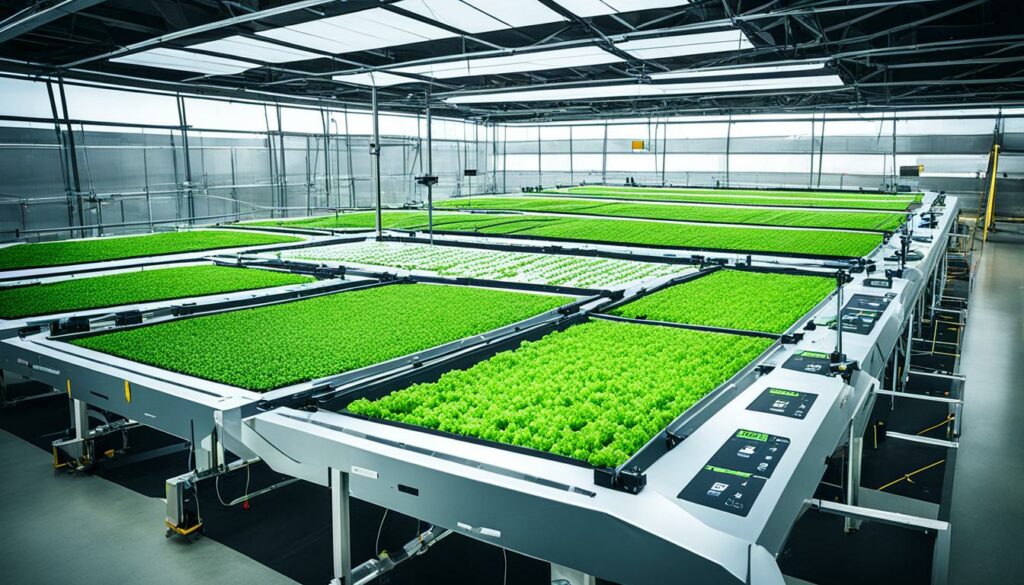
IoT helps by tracking everything on farms in real-time easily. Telstra’s Cat M1 network plays a big role here. It offers great coverage across Australia, which keeps IoT systems safe and connected.
| Security Concerns | Impact on IoT in Farming |
|---|---|
| Cybersecurity Threats | Increased vulnerability to cyber-attacks, compromising data and operational integrity |
| Rising Cybercrime | Greater need for stringent security protocols, especially post-COVID-19 pandemic |
| Default Credential Exploits | Urgency for securing SSH and Telnet login interfaces to prevent breaches |
There has been a big increase in farming IoT cyberattacks, especially due to COVID-19. Thieves use basic passwords to get into the system. It’s very important to keep these logins safe to protect farms.
The future of farming, called precision agriculture, heavily relies on IoT. This includes things like mobile apps and drones. But, without good security, this tech can be risky. It might lead to data loss, food issues, or even danger to life.
In conclusion, strong IoT security is crucial for farming to be both safe and productive. Protecting the farm’s physical assets and its data is key. This helps in keeping the agriculture sector safer and more efficient.
Rural broadband access is very important for modern farming. Many farmers now use IoT devices. They predict over 75 million IoT devices will be in use by 2020.
A strong internet connection is a must for farming now. The Biden administration has put $40 billion into making internet better across the country. This shows how important it is to close the digital gap.
LoRaWAN is crucial for wireless farming tech. It’s great for IoT on a big scale. LoRaWAN is cheaper to run and set up.
It can make sensors work for over 10 years. You need fewer gateways to cover big areas. This tech is perfect for the countryside. Sensors can send data over long distances, even in tough places. This makes sure internet in rural areas works well.
Many rural places don’t have fast internet. This keeps a lot of people in farming away from the internet. Making private networks that spread the internet around farms can help. For example, farmers can use RFID tags on animals that can send data wirelessly. This helps with managing animals better in real-time.
There’s also edge computing. It makes the internet work faster. This is key for systems that watch over farms, online learning, and healthcare in the country.
Using things like cameras and sensors can make farms safer from diseases. These devices can spot diseases early, which saves money and keeps animals healthy. By using private networks, farms can cover big areas with a strong internet. This helps them use data to make better decisions.
| Technology | Advantage |
|---|---|
| LoRaWAN | Lower cost, long-range connectivity |
| Private Cellular Networks | Extended LAN connectivity over large farms |
| Edge Computing | Reduces latency by processing data locally |
| RFID Ear Tags | Real-time insights and extended data collection range |
| Mesh Networks | Robust coverage across extensive rural areas |
In closing, improving internet access in farming is crucial. It helps farmers use IoT tech better. This can lead to more connected, productive, and green farms.
Innovative agritech solutions are making big changes in farming. They are focusing on making farming better and more sustainable. The World Government Summit’s report named “Agriculture 4.0 – The future of farming technology” talks about three main trends. These are new techniques, better efficiency, and using tech like IoT and Data Analytics everywhere.
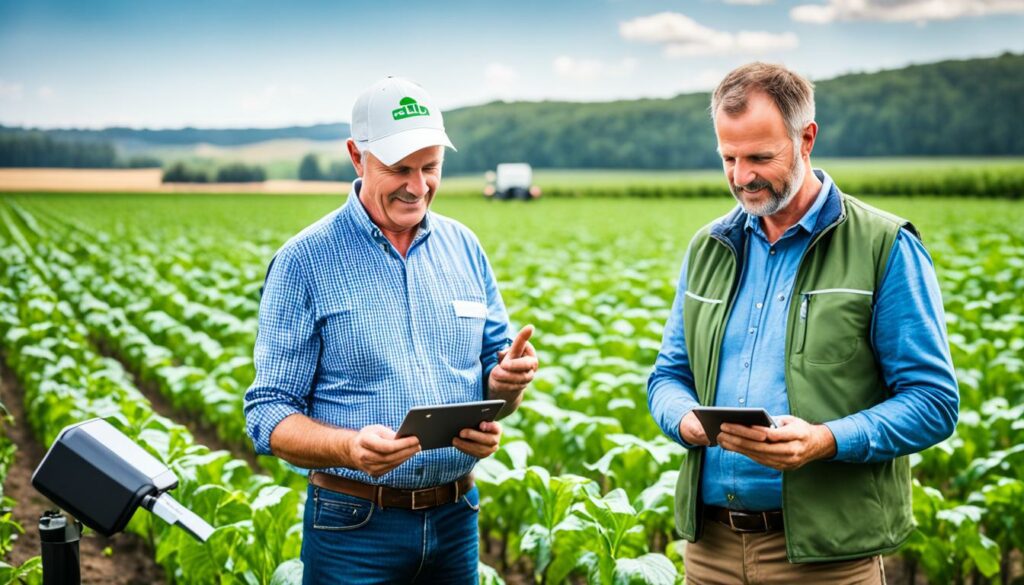
IOT and Data Analytics are changing agriculture a lot, increasing safety and how much crops farmers grow. Newer tech like Blockchain and Artificial Intelligence (AI) are helping too, making decisions and work more efficient. With IOT, farmers can check soil health, watch the weather, and track animals easily. This helps them use resources better, grow more, and harm the environment less.
Many examples show how much new agritech helps. For example, Manx Technology Group (MTG) makes IoT tools for checking soil, smart watering, and weather. These tools cut costs and boost production a lot, which is great news for farmers, agricultural groups, and councils. The UN says we need to make 70% more food by 2050. We need these advancements a lot to meet these goals.
In dairy farming, nearly 60% of the cost is from feeding animals and paying workers. IOT tools can check on animals’ health, catch issues early, and help make more food. This shows how powerful agritech can be. Also, in places with shared farming tools, using IOT has made things cheaper and better, proving it’s a good way to go.
Eseye’s IoT tech is giving nearly perfect uptime for agritech, powered by smart SIM cards and routers. This kind of tech is super important for the UN’s Sustainable Development Goals (SDGs). These goals want to end hunger and help farming be more sustainable.
“Around 50% of water used for irrigation is wasted due to inefficient techniques; integrating IoT can significantly mitigate this wastage,” – UN Food and Agriculture Organization.
The benefits of IoT in farming are many. But, there are also challenges to adopting IoT. These include risks to data privacy and the need for big investments upfront. Farmers need to focus on how to keep their data safe. As more devices connect, the chances of a data breach go up. Strong encryption and careful data handling are key as farms get more connected.
Data security in farming is a big deal. More IoT devices mean a bigger risk of data breaches. To protect their data, farmers must use strong cybersecurity. Teaching farmers about data security helps make their data safer. But, mixing different gadgets can be hard. This is because there are no set rules for how they should work together.
Starting with IoT in farming can cost a lot. Buying and setting up IoT tools is expensive, especially for small farms. Plus, keeping these systems running also costs money. Knowing the financial side of IoT use is important. This helps encourage more use of IoT in farming.
| Challenges | Details |
|---|---|
| Data Privacy | Increased data breaches with connectivity, necessitating encryption and data management. |
| High Initial Investment | Significant financial outlay for IoT devices, especially hard for smaller farms. |
| Interoperability | Absence of standard protocols leads to fragmentation and integration issues. |
| Rural Connectivity | Weak internet infrastructure in rural areas hampers effective IoT integration. |
Investing in farm tech is key. But, there are challenges like limited connectivity and device compatibility. Finding new ways and planning smartly can help. This is needed to make full use of IoT in farming.
Looking at real-life uses, an IoT case study in crop management shows the big changes this tech can bring. IoT in farming has completely changed how we monitor and manage crops. It offers big advantages that show its importance in today’s agriculture.
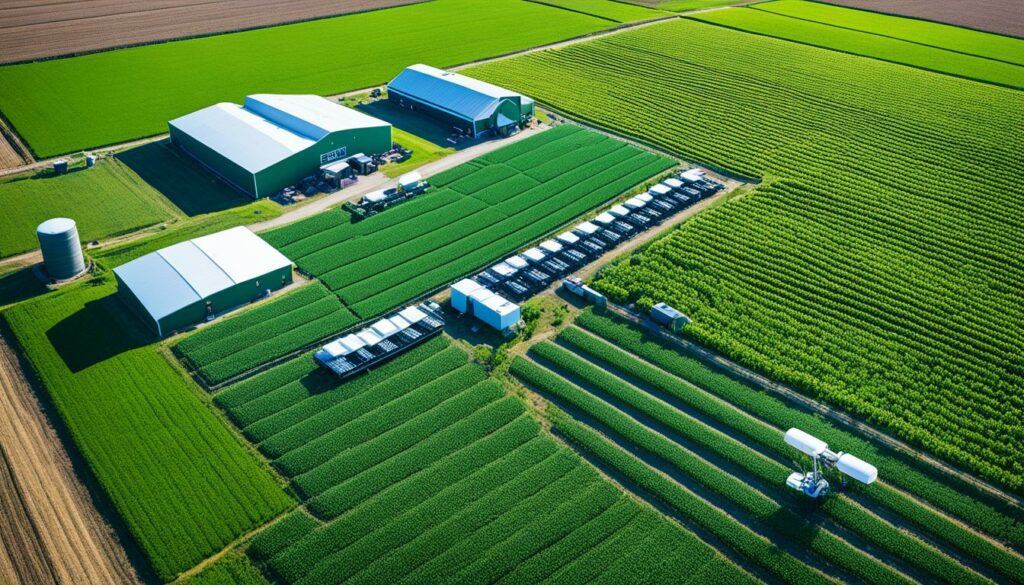
The use of IoT in agriculture reached a $13.76 billion market share in 2022. This figure is growing by 9.9% yearly due to the pandemic’s effects. It points to the growing need for precision farming, which uses real-time data and predictions to improve crop care.
Precision agriculture is a key part of how we manage crops today. It uses IoT to figure out the best amounts of water, fertilisers, and pesticides needed by plants. This makes things more efficient and cheaper. For example, drones from companies like DroneSeed and SenseFly help plant trees and check on crops. This move towards smarter farming is more sustainable for the environment.
Looking at technology in agriculture, it’s clear that predictive analytics are vital. They help farmers know the best times to harvest, spot disease risks, and guess how much yield they’ll get. This tech isn’t just about productivity; it’s also about making crops healthier and stronger. Market experts think the smart farming industry could reach $28.56 billion by 2030, showing a move towards smarter, data-focused farming.
“Innovative IoT solutions are transforming crop management, making agriculture smarter and more efficient than ever before,” says a leading researcher in agritech.
To wrap up, using IoT in crop management is a big step forward for farming. The smart agriculture market is expected to get three times bigger by 2025. All signs show that IoT is changing the future of agriculture for the better.
In today’s farming, IoT has made big changes to how livestock is managed. This change is clear in many studies and reports. They show how much these new technologies help in making livestock farming better.
Sensors played a big part, making up 51% of the market in 2016. They work alongside RFID tags. This technology lets farmers keep a close eye on their animals. They can check things like heart rate, temperature, and what they eat. Keeping track of this helps farmers improve how they look after their animals.
IoT also helps with real-time data collection. This means farmers can know right away if an animal is sick or behaving differently. Instead of relying on hard work and sometimes wrong data, they now have accurate, fast information. This new way of working saves money on labour. It also makes the farm more productive.
The use of IoT in livestock management is growing fast, with a 12.1% growth expected by 2029. It’s estimated to reach USD 11.18 billion in market size by then. Plan and make sure animals are healthy through IoT. It’s now a must-have for farmers.
“The integration of IoT in livestock management transforms farming practices, making them more efficient and sustainable, ultimately leading to better animal welfare,” experts emphasise.
But, there are challenges to face, like the high cost to start, connecting everything, and keeping the data safe. Small and medium farms find it harder because of their size. Plus, we need to know more about the long-lasting effects of using IoT. This will help ensure those who use it get more than just money.
| Key Focus Areas | Challenges |
|---|---|
| Disease Prevention and Management | Connectivity Issues |
| Reproductive Health Monitoring | Data Security Concerns |
| Overall Farm Management Practices | Initial Setup Costs |
To wrap up, IoT is ready to change the game in livestock management. It’s aiming for smarter and more effective farming. The upcoming years see a lot of potential for this tech to make farming sustainable and productive.
The future of farming is getting shaped more and more by IoT. By 2026, the global market for agricultural IoT could hit $13 billion. This change means farming will get smarter, reducing costs and helping the environment.
IoT is bringing lots of chances for those in agriculture. John Deere uses IoT to make farming tasks like planting and harvesting better. Through sensors and devices, they’re pushing farming forward, making it more productive and efficient.
AI and machine learning are key to farming’s future. By crunching data, they help farmers make smarter decisions. For example, they can manage farms remotely, keeping an eye on crops and pests. This means better timing for applying resources, which is great for the farm.
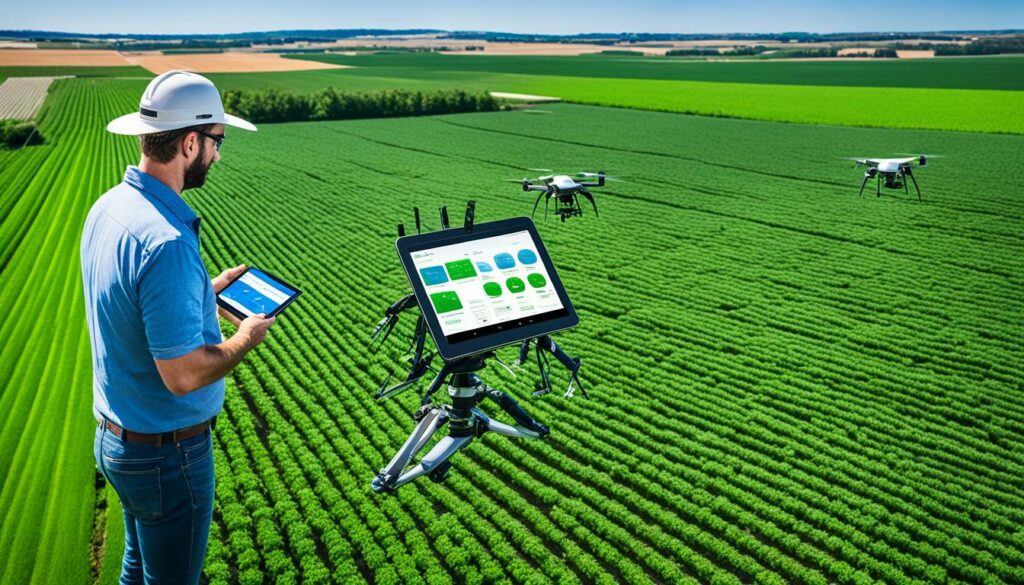
Using IoT devices makes farms more efficient and productive. They help with everything from crop planning to automating the watering. This makes farming operations smoother and more effective.
| Component | Function | Impact |
|---|---|---|
| Sensors | Soil, Water, Light, Humidity, Temperature Management | Enhanced Resource Management and Precision Farming |
| Robotics | Automated Machinery for Planting, Harvesting | Increased Efficiency and Reduced Labour Dependency |
| Drones | Crop Health Assessment, Irrigation, Monitoring | Valuable Insights into Plant Health and Yield Predictions |
In the end, IoT, AI, and machine learning are changing farming for the better. They make farming more precise, efficient, and green. This change is good for big farms and small ones, like organic and family farms. It leads to a healthier and more productive farming future.
The world’s population is heading towards 9.7 billion by 2050 and close to 11 billion by 2100. This growth shows the need for smarter farming. Adding IoT to farming isn’t just clever; it’s crucial for the future. IoT is changing farming by making it more efficient, productive, and better for the environment. This supports the aims of the “How to Feed the World 2050” report.
But there are hurdles in using IoT, like the high cost at the start and needing technical skills. Privacy and security worries are also important. Yet, facing these issues will make IoT a game-changer for farming. We’ve already seen big steps in farming tech, like smart irrigation and tracking livestock using smart sensors. This work is showcased in studies by IEEE and the Sustainability journal. With the world’s IoT devices set to nearly double from 15.1 billion in 2020 to over 29 billion by 2030, IoT’s role in farming looks bright.
To wrap up, IoT is leading farming into a more modern, efficient, and eco-friendly direction. Overcoming problems like rural internet and costs, IoT is helping us grow more food in safer ways. It’s making farms not only more productive but also better places to work, with safety a top priority. The rise of AI and machine learning in agriculture hints at a future where we can feed everyone safely, without harming the planet.
IoT in farming means using smart devices to oversee and run farm jobs. This boosts safety by checking on the health of workers and animals in real time. It helps create workspaces that are safer.
IoT tech is used in precision agriculture to fine-tune how crops are managed. It makes sure pesticides and fertilisers are used precisely. This leads to better use of resources and more crops.
Sensor networks use many sensors to watch over things like soil dampness and the weather. This data in the moment lets farmers make smart choices to look after their crops better.
Agricultural robots and drones do jobs like putting seeds in, watching over, and collecting crops. They make the work faster and cheaper. Drones are very handy for checking on crops and spraying them exactly.
IoT helps keep an eye on the health and behaviour of animals all the time with tiny gadgets they wear. This leads to quick actions that make animals healthier and work better.
Good connections in the country are key for IoT to work well on farms. They make sure data flows easily from faraway farms to the main systems in charge.
There are a few hurdles, such as keeping data safe and the high cost to start. Plus, the systems need constant care and updates.
AI makes sense of lots of data from IoT gadgets. This helps make better choices, leading to farming that’s both smarter and more eco-friendly.
One case is using IoT sensors to keep an eye on how moist the soil is. This info is then used to water the crops automatically. It’s cut down on water use and made the crops healthier.
In the future, we’ll see more AI for planning, more automation on the farms, and better internet to tie it all together. This will help IoT to grow a lot in farming.
To keep data safe, strong encryption and careful data management are used. This makes sure the huge amount of data from IoT devices on farms is handled and stored securely.